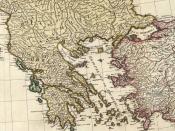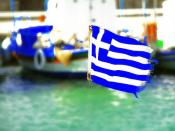Greece Greece is a country in southeastern Europe, taking up most of the Balkan Peninsula and has over 2,000 islands. It is bordered by Albania, Macedonia, and Bulgaria to the north; Turkey to the east, and mostly surrounded by water. Athens is the largest and capital city in Greece.
Geography- Physical Characteristics- Greece is commonly visited by tourists because of its natural beauty. It is very mountainous, almost four-fifths of it is mountains. One of the most famous and highest mountain is Mt. Olympus it stands at over 9500 ft. In ancient Greek mythology, Mt. Olympus was thought of as the home of the gods.
There are different regions of Greece: the central mountain area, the Pindus; the southeastern part of central Greece, Attica; and the large plain of the eastern coast, Boeotia.
Climate- The climate of Greece is split into two major sections. The northern part of Greece is a temperate climate where is it usually cool and wet.
The southern part is a Mediterranean climate where it is usually warm, but winters and mildly wet and summers are hot and dry. The thousands of island are also a Mediterranean climate, except a little bit hotter.
Location- The relative location of Greece is: it is surrounded by Albania, Macedonia, Bulgaria, Turkey, the Aegean Sea, the Ionian Sea, plus the Mediterranean Sea. The absolute location of Greece is: it from 20ð East-26ýð East and 41ýð North- 35ð North. Natural Resources- Greece is a very poor country and doesn't have any natural sources of real worth, but Greece does have a few unique things known to its country. They haves mine that receive lignite, bauxite, magnesium, salt, iron ore, chromium, lead, zinc, silver, nickel, copper, and uranium. Also they have many agricultural resources like wheat, olives, cotton, tobacco, oats, barley,


